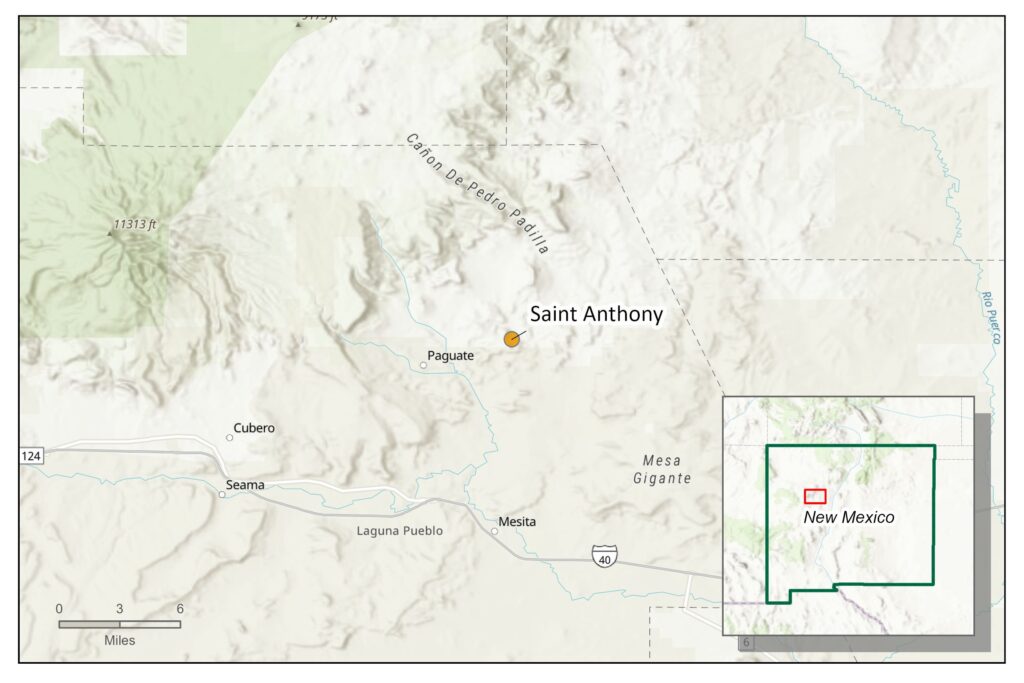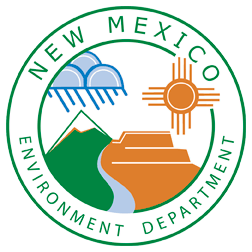Location
The St. Anthony Mine site is located in the Grants Uranium District, Laguna subdistrict, 31 miles east of Grants, New Mexico, in Cibola County. It is located within Township 11 North, Range 4 and 5 West, at the base of the northern and eastern slopes of the Gavilan Mesa. The mine is located on the Cebolleta Land Grant.

Ownership and History
St. Anthony Mine and all surface and mineral rights are owned by the Cebolleta Land Grant, administered by a Board of Trustees, and were leased to the United Nuclear Corporation (UNC), which is a wholly owned subsidiary of General Electric, for mining purposes from February 1964 until they surrendered it through a Release of Mineral Lease in October 1988. UNC is responsible for reclamation and groundwater abatement of the St. Anthony Mine pursuant to a Mining Act Permit and abatement plan with the New Mexico Environment Department (NMED). Records indicate uranium was mined at the St. Anthony Mine through an underground mine operation starting around the site discovery in 1955 and up until the early 1960s by the Anthony Uranium Company, a division of Climax Molybdenum Company (additional information on the underground mine operation is not available). UNC then operated the site from 1975 through 1981. UNC performed mining using underground and surface methods. UNC initiated open pit mining in November 1975 and continued until August 1980. Two open pits were mined; one large (referred to as Pit 1) and one small (referred to as Pit 2). The large open pit is approximately 1,900 feet in diameter. It extends into the ore-bearing Jackpile Sandstone unit of the Morrison Formation and intercepts groundwater. The small pit is 700 feet in diameter, and it does not intercept groundwater or the targeted ore body. The St. Anthony Mine also includes an underground mine with a 357-foot shaft that extends into the Jackpile Sandstone. Shaft construction began in January 1977 and underground mining ceased in June 1980. From 1975 to 1980, the mine produced approximately 1.6 million pounds of uranium ore. Mining operations left one mine shaft and one vent shaft (both capped at the surface in 1984 and 1985, respectively), two open pits, several waste rock piles, three topsoil or overburden piles, building and shaft pads, and former settling ponds. Stockpiled ore from the St. Anthony Mine was processed off site primarily at the UNC Church Rock Mill near Gallup, New Mexico.
Reclamation & Regulatory Jurisdiction
UNC is the responsible party for the St. Anthony Mine site and is responsible for all abatement and reclamation actions. There is no groundwater discharge permit associated with the site, but the site is regulated under the abatement rules in 20.6.2 NMAC. The site also is regulated under a Mining Act permit with EMNRD-MMD
NMED
Uranium mining at the site was conducted in accordance with the then-current regulations and industry standards. After some initial investigations, NMED required UNC to submit a Stage 1 Abatement Plan in January 2002. UNC submitted the Stage 1 Abatement Plan in August 2002, and it was approved with conditions by NMED in November 2002. The Stage 1 Abatement Report was submitted in October 2006 and later approved after a series of communications between NMED and UNC. In November 2008, UNC submitted the Stage 2 abatement workplan. The Stage 2 abatement work progressed, and a revised report was submitted and subsequently approved in April 2012. A final Stage 2 Abatement Plan Report was submitted in September 2014, and later revised in February 2015, with conditional approval in May 2015. An Alternative Abatement Standards Petition was submitted in July 2017, initiating a hearing UNC completed abatement activities in 2018 and the Water Quality Control Commission (WQCC) approved Alternative Abatement Standards and issued a Final Order that outlined the reclamation remedy to be a complete backfill of the large pit, as well as a well prohibition from the Office of the State Engineer. After a series of meetings between UNC, NMED, and MMD from 2020-2022 it was determined that UNC did not intend to follow the approved abatement remedy of full backfill of the large pit, NMED directed UNC to submit a Stage 2 Abatement Modification and revised Closure/Closeout Plan in 2022. The Stage 2 Abatement Modification and revised Closure/Closeout Plan was submitted in 2022 and is under review by NMED. MECS staff are exchanging information with the permittee and approval of Closure Plan will not be final until MMD determines that the Closeout Plan is technically complete.

Regulatory Tracks
- No discharge permits are registered with NMED.
- Under NMED, the St. Anthony Mine is regulated under an abatement plan, which addresses remediation of groundwater impacts, and long-term groundwater monitoring.
- Under EMNRD-MMD, the St. Anthony Mine is regulated under a Mining Act Permit, which addresses surface reclamation.
EMNRD-MMD
The St. Anthony Mine is in full reclamation status. As part of the Stage 2 Abatement Plan Modification, UNC also submitted a Closure/Closeout Plan (CCP) to both NMED and MMD to satisfy the requirements of sitewide closeout under the Mining Act. Currently, the MMD Permit is in process with the submitted CCP under review. MMD sent the first round of comments on the CCP to the operator in May 2023. In August 2023, MMD received the mine operator’s response to the first round of comments, MMD sent a second round of comments on the CCP to UNC in February 2024 with UNC responding in July 2024. MMD is still in review of the submittal. MMD and UNC will continue the permitting process. The St. Anthony Mine site is designated under Mining Act Permit No. MK006RE.

Timelines for the Completion of Cleanup Activities
The CCP has been submitted with the first round of MMD and EMNRD comments sent to UNC. More discussion and rounds of comments will be needed to determine that the CCP is technically approvable, and the Mining Act Permit can be issued. Once the Mining Act Permit is issued, the current plan submitted by UNC includes a half year of contracting and three years of construction before completion of the project. A minimum of 12 years of monitoring will be required by MMD before the Mining Act Permit can be released, which is contingent upon a demonstration that UNC is meeting the standards under the Mining Act. NMED is reviewing the Stage 2 modification and will require additional information prior to determining that the remedy as proposed will protect human health and the environment. This process will likely involve numerous rounds of comments between UNC and NMED prior to any approval of the Stage 2 modification. After the Stage 2 modification is approved by NMED, UNC will need to petition the WQCC to modify the Final Order and implement additional Alternative Abatement Standards. The WQCC will hold a hearing to address the modification to the Stage 2 Abatement Plan. NMED will require groundwater monitoring to continue on the site.
Coordination Between State and Federal Agencies
St. Anthony Mine is regulated by two New Mexico agencies: NMED and EMNRD-MMD. St. Anthony Mine is not regulated by the U.S. Nuclear Regulatory Commission nor the U.S. Department of Energy. There are no federal agencies regulating this site. Therefore, coordination with federal agencies is not anticipated due to unconnected regulatory jurisdiction.
Anticipated Funding Requirements
Funding for all site reclamation, abatement, remediation, and long-term monitoring actions regulated by NMED and EMNRD-MMD are covered by UNC, the responsible party for the St. Anthony Mine site. Additionally, jointly held financial assurance between NMED and EMNRD-MMD—totaling $97,759,617—is in place for cleanup activities in the event of a forfeiture. There is no anticipated funding needed from the state or other entity for St. Anthony Mine. UNC is responsible for all costs associated with closure and abatement.
Disclaimer
Site reviews in this report provide the reader with a general history and status of permitted mines and mills. For brevity, they may not provide all relevant details or agency actions related to each site.

